City of Brussels
The City of Brussels (French: Ville de Bruxelles [vil də bʁysɛl] or alternatively Bruxelles-Ville [bʁysɛl vil]; Dutch: Stad Brussel [stɑd ˈbrʏsəl] or Brussel-Stad [ˌbrʏsəl ˈstɑt]) is the largest municipality and historical centre of the Brussels-Capital Region, as well as the capital of the Flemish Region (from which it is separate) and Belgium.[2] The City of Brussels is also the administrative centre of the European Union, as it hosts a number of principal EU institutions in its European Quarter.[3][4][lower-alpha 1]
City of Brussels
| |
|---|---|
City and municipality | |
.jpg.webp) Panorama of the city centre from the Mont des Arts/Kunstberg | |
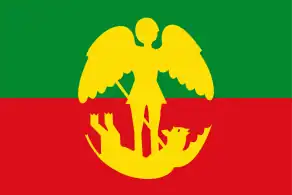 Flag  Coat of arms | |
Location of City of Brussels | |
 City of Brussels Location in Belgium
The City of Brussels within Brussels-Capital Region  | |
| Coordinates: 50°50′48″N 04°21′09″E | |
| Country | |
| Community | Flemish Community French Community |
| Region | Brussels-Capital |
| Arrondissement | Brussels-Capital |
| Government | |
| • Mayor (list) | Philippe Close (PS) |
| • Governing party/ies | PS - Ecolo / Groen, DéFI - Forward |
| Area | |
| • Total | 33.09 km2 (12.78 sq mi) |
| Population (2022-01-01)[1] | |
| • Total | 188,737 |
| • Density | 5,700/km2 (15,000/sq mi) |
| Postal codes | 1000, 1020, 1120, 1130 |
| NIS code | 21004 |
| Area codes | 02 |
| Website | www.brussels.be |
Besides the central historic town located within the Pentagon, the City of Brussels covers some of the city's immediate outskirts within the greater Brussels-Capital Region, namely the former municipalities of Haren, Laeken, and Neder-Over-Heembeek to the north, as well as the Avenue Louise/Louizalaan and the Bois de la Cambre/Ter Kamerenbos park to the south-east, where it borders municipalities in Flanders.
As of 1 January 2023, the City of Brussels had a population of 194,291 inhabitants. The total area is 33.09 km2 (12.78 sq mi) which gives a population density of 5,704/km2 (14,770/sq mi). As of 2007, there were 75,998 registered non-Belgians in the City [5] In common with all of Brussels' municipalities, it is legally bilingual (French–Dutch).
Territorial history

Historically, the City of Brussels was simply defined, being the area within the second walls of Brussels, the modern-day Small Ring (Brussels' inner ring road). As the city grew, the surrounding villages grew as well, eventually growing into a contiguous city, though the local governments retained control of their respective areas.
The construction of the Avenue Louise/Louizalaan was commissioned in 1847 as a monumental avenue bordered by chestnut trees that would allow easy access to the popular recreational area of the Bois de la Cambre/Ter Kamerenbos. However, fierce resistance to the project was put up by the town of Ixelles (which was then still separate from Brussels) through whose land the avenue was supposed to run. After years of fruitless negotiations, Brussels finally annexed the narrow band of land needed for the avenue plus the Bois de la Cambre itself in 1864. That decision accounts for the unusual south-eastern protrusion of the City of Brussels and for Ixelles being split in two separate parts. Part of the Université libre de Bruxelles (ULB)'s Solbosch campus is also part of the City of Brussels, partially accounting for the bulge in the south-eastern end.
Unlike most of the municipalities in Belgium, the ones located in the Brussels-Capital Region were not merged with others during mergers occurring in 1964, 1970, and 1975.[6] However, a few neighbouring municipalities have been merged into the City of Brussels, including Haren, Laeken and Neder-Over-Heembeek in 1921.[7] These comprise the northern bulge in the municipality. To the south-east is also a strip of land along the Avenue Louise that was annexed from Ixelles.
Quarters

Pentagon
Central Quarter
It is in the heart of Saint-Géry/Sint-Goriks Island, formed by the Senne river, and on which a first keep was built around 979, that the origin of Brussels is located. Today, the neighbourhood around the Halles Saint-Géry/Sint-Gorikshallen, a former covered market, is one of the trendiest districts of the capital. In this Central Quarter (French: Quartier du Centre, Dutch: Centrumwijk), there are some vestiges of the 13th-century first walls of Brussels, which surrounded the area between the first port on the Senne, the old Romanesque church (later replaced by the Brabantine Gothic Cathedral of St. Michael and St. Gudula), and the former ducal palace of Coudenberg in today's Royal Quarter. In the centre of this triangle are the Grand-Place/Grote Markt (Brussels' main square); the Îlot Sacré district, which takes its name from its resistance to demolition projects, itself crossed by the Royal Saint-Hubert Galleries; the Saint-Jacques/Sint-Jacobs district, which welcomed the pilgrims on their way to Santiago de Compostela; as well as the former Brussels Stock Exchange building, built on the site of a former Franciscan convent, whose remains have been uncovered.[8]
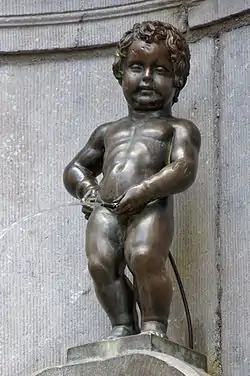
_St._Michael_%2526_St._Gudula_Cathedral_Tower%252C_Brussels.jpg.webp)

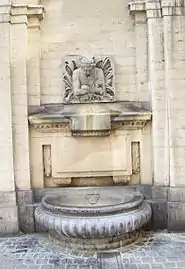 Le Cracheur fountain
Le Cracheur fountain
Royal Quarter
The Royal Quarter (French: Quartier Royal, Dutch: Koninklijke Wijk or Koningswijk) is thus named because it houses, on the one hand, the Place Royale/Koningsplein ("Royal Square" or "King's Square"), built under Charles-Alexander of Lorraine on the Coudenberg hill, on the site of the former Palace of the Dukes of Brabant, of which certain levels of foundation still exist, and on the other hand, the Royal Palace of Brussels, which faces Brussels Park, on the other side of which is the Belgian House of Parliament (Palace of the Nation). Below the Royal District is the Central Station and the Mont des Arts/Kunstberg where the Royal Library of Belgium (KBR), the Royal Belgian Film Archive (Cinematek), the Brussels Centre for Fine Arts, the Museum of Cinema, the Musical Instruments Museum (MIM), the BELvue Museum, and the Royal Museums of Fine Arts of Belgium are located.
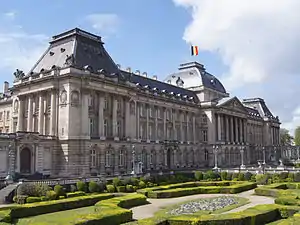
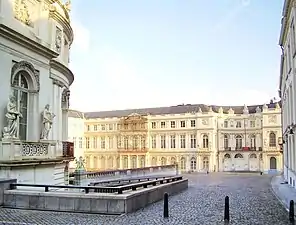 Place du Musée/Museumplein
Place du Musée/Museumplein
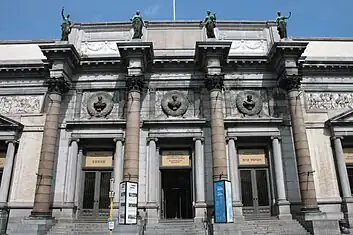

Sablon/Zavel Quarter
From the Place Royale/Koningsplein, the Rue de la Régence/Regentschapsstraat crosses the Sablon/Zavel Quarter (French: Quartier des Sablons, Dutch: Zavelwijk), made of the larger Grand Sablon/Grote Zavel ("Large Sablon") square in the north-west and the smaller Petit Sablon/Kleine Zavel ("Small Sablon") square and garden in the south-east, divided by the Church of Our Blessed Lady of the Sablon. It is a swanky quarter, where an antiques market is held, and in which antique and art dealers, as well as other luxury shops, have their businesses. Not far from there stood the Art Nouveau Maison du Peuple/Volkshuis by the famous architect Victor Horta, until its demolition in 1965. The Sablon is also home to the Egmont Palace and the Royal Conservatory of Brussels.
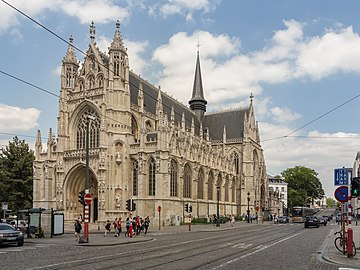
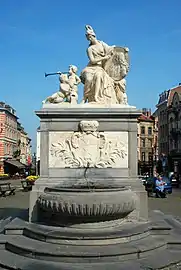 Fountain of Minerva
Fountain of Minerva
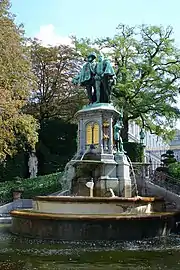 Fountain of the Counts of Egmont and Horn
Fountain of the Counts of Egmont and Horn
Marolles/Marollen Quarter
In the shadow of the gigantic Palace of Justice lies the old Marolles/Marollen Quarter (French: Quartier des Marolles, Dutch: Marollenwijk, not to be confused with the Marolle that purists delimit to only seven streets). From the Place de la Chapelle/Kapellemarkt to the Place du Jeu de Balle/Vossenplein, where a daily flea market known as the Old Market has been held since 1873, along the Rue Haute/Hogestraat and the Rue Blaes/Blaestraat, second-hand and popular shops have for some years given way to antique shops, marking a profound change to the neighbourhood. The Cité Hellemans, a remarkable example of early 20th-century collective housing complexes, was built on the site of the neighbourhood's many squalid cul-de-sacs. The Rue Haute, one of the longest and oldest streets in the city, follows the course of an old Gallo-Roman road, and runs along Saint Peter's Hospital, built in 1935 on the site of a lepers' hospital, to end at the Halle Gate, the only survivor of the series of gates which allowed passage inside the second walls of Brussels.
 Place du Jeu de Balle/Vossenplein, end of a market
Place du Jeu de Balle/Vossenplein, end of a market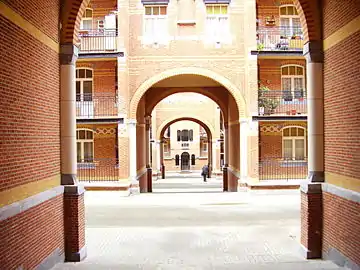 Cité Hellemans, Rue Blaes/Blaesstraat
Cité Hellemans, Rue Blaes/Blaesstraat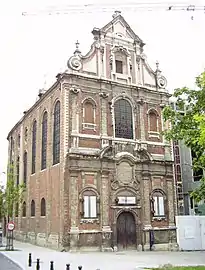 Brigittines Chapel
Brigittines Chapel
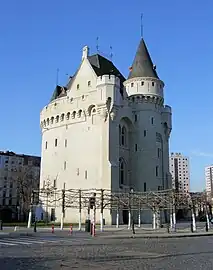
Midi–Lemonnier or Stalingrad Quarter
It is in the heart of the Midi–Lemonnier Quarter (French: Quartier Midi–Lemonnier, Dutch: Lemmonier–Zuidwijk), where the Place Rouppe/Rouppeplein is today, that Brussels' first South Station—called Bogards' railway station for the eponymous convent whose site it was built on, and to which the Rue des Bogards/Bogaardenstraat is nowadays the only reference—was located from 1839, the terminus of the South Line. The former presence of a station at this location also explains the unusual width of the current Avenue de Stalingrad/Stalingradlaan, which goes from the square to the Small Ring, cleared of its railways since the inauguration of Brussels-South Station, built outside the Pentagon in 1869. Because of this, the neighbourhood is sometimes called the Stalingrad Quarter (French: Quartier Stalingrad, Dutch: Stalingradwijk). At the same time, following the covering of the Senne, the neighbourhood saw the construction of Haussmann-esque grand central boulevards, including the Boulevard Maurice Lemonnier/Maurice Lemonnierlaan, bordered by the Place Fontainas/Fontainasplein and the Place Anneessens/Anneessensplein (former location of the Old Market), as well as by the Midi Palace. Each Sunday morning, the Midi district hosts the second largest market in Europe.
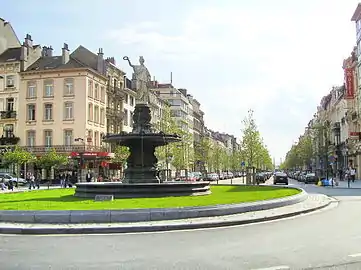
 Place Anneessens/Anneessensplein (François Anneessens) and Haute École Francisco Ferrer
Place Anneessens/Anneessensplein (François Anneessens) and Haute École Francisco Ferrer Midi Palace on the Boulevard Maurice Lemonnier/Maurice Lemonnierlaan
Midi Palace on the Boulevard Maurice Lemonnier/Maurice Lemonnierlaan
Senne/Zenne or Dansaert Quarter
The damp and swampy grounds around the present-day Rue de la Senne/Zennestraat and Rue des Fabriques/Fabriekstraat were occupied by craftsmen since the Middle Ages. An arm of the river crossed the defences of the second walls at the level of the Ninove Gate and the Petite Écluse/Kleine Sluis ("Small Lock"), which served as a port, an end of which remaining there until the 1960s. Later, small industries and many artisan breweries (now disappeared) established themselves in the area, which is still evident by the names of the Rue du Houblon/Hopstraat ("Hops Street") and the Rue du Vieux Marché aux Grains/Oude Graanmarktstraat ("Old Grain Market Street"). The Shot Tower (Tour à Plomb), which was used for the manufacture of lead shot for hunting, and the Rue de la Poudrière/Kruitmolenstraat ("Gunpowder Street"), also testify to the neighbourhood's former activities. Long neglected as a result of the relocation of businesses outside the city centre, the Senne/Zenne Quarter (French: Quartier de la Senne, Dutch: Zennewijk) has for a few years been the object of a new interest and is undergoing gentrification due to the many disused industrial premises being converted into lofts. The area around the Rue Antoine Dansaert/Antoine Dansaertstraat has become a trendy district and is attracting a younger, more well-off, and mostly Dutch-speaking population. This new situation, which has the consequence of rising rents, is not without problems for the less fortunate inhabitants of the neighbourhood.
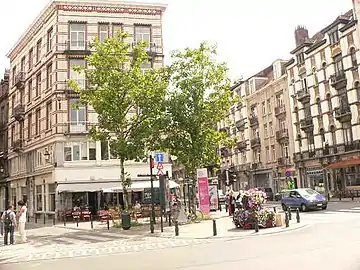 Rue Antoine Dansaert/Antoine Dansaertstraat
Rue Antoine Dansaert/Antoine Dansaertstraat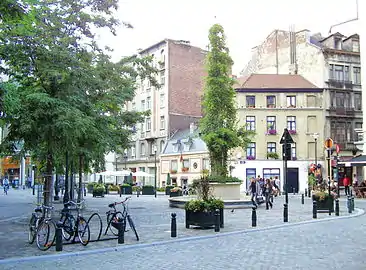 Place du Jardin aux Fleurs/Bloemenhofplein
Place du Jardin aux Fleurs/Bloemenhofplein Industrial building transformed into housing (loft)
Industrial building transformed into housing (loft)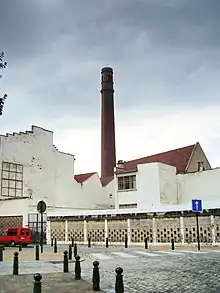
Quays or Maritime Quarter
The Quays Quarter (French: Quartier des Quais, Dutch: Kaaienwijk) is that of the old Port of Brussels, which played for a long time the role of "belly" of the city. The boats coming from the Scheldt river penetrated through the former Shore Gate (French: Porte du Rivage, Dutch: Oeverpoort), at the site of present-day Place de l'Yser/Ijzerplein, to join one of the canals, whose docks were each reserved for one type of goods. Filled in the late 19th century, at the opening of Brussels' new port, these basins were replaced by wide boulevards, the two sides of which retain in their names the memory of their former function: the Quai aux Briques/Baksteenkaai ("Brick Wharf"), the Quai au Bois à Brûler/Brandhoutkaai ("Firewood Wharf"), the Quai aux Pierres de Taille/Arduinkaai ("Quarry Stone Wharf"), the Quai au Foin/Hooikaai ("Hay Wharf"), etc., or references to the neighbourhood's commercial activities: the Rue du Magasin/Pakhuisstraat ("Warehouse Street"), the Rue des Commerçants/Koopliedenstraat ("Traders Street"), the Rue du Marché aux Porcs/Varkensmarktstraat ("Pig Market Street") and the Quai du Commerce/Handelskaai ("Trade Wharf"). Along the quaysides, numerous bourgeois houses, once belonging to wealthy merchants, have preserved the entrances to the warehouses. On the Boulevard d'Ypres/Ieperlaan, one can still cross food wholesalers, supplied nowadays by trucks, which have replaced the boats. The neighbourhood also includes the beguinage of Brussels, with the Church of St. John the Baptist and the remarkable Grand Hospice Pachéco.
.jpg.webp)
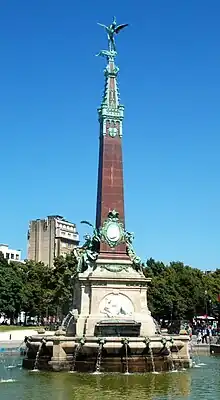

 Potale Saint Roch, invoked against the plague
Potale Saint Roch, invoked against the plague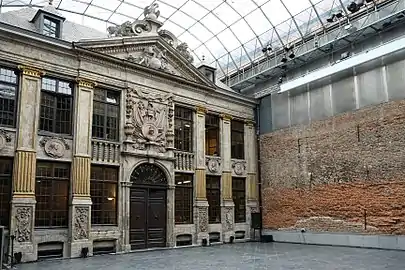 La Bellone
La Bellone
Marais–Jacqmain Quarter
Few of the buildings in the Marais–Jacqmain Quarter (French: Quartier Marais–Jacqmain, Dutch: Jacqmain–Broekwijk) have escaped 20th-century demolition, from the Boulevard Pachéco/Pachecolaan to the Rue Neuve/Nieuwstraat. They have been replaced by the State Administrative City, press printers, banking facilities, and commercial galleries. The current trend is to restore the neighbourhood's social mix by redeveloping former office buildings into housing. Despite the long-time grim aspect of the district, the Meyboom tradition has been maintained for centuries, and the former Art Nouveau Magasins Waucquez by Victor Horta have been preserved and house, since 1993, the Belgian Comic Strip Center. Another preserved islet is the 18th-century neoclassical Place des Martyrs/Martelaarsplein, which has gradually been renovated. The victims of the Belgian Revolution of 1830 are buried there in an open crypt with a memorial. Nearby is the Rue Neuve, one of the main commercial streets in Belgium, with its two sides, more than 1 kilometre (0.62 mi) long, nearly entirely occupied by shops; the Boulevard Adolphe Max/Adolphe Maxlaan, a traditional 19th-century artery; and the Boulevard Émile Jacqmain/Émile Jacqmainlaan (where the National Theatre of Belgium has been installed since 2004) close to the Place de Brouckère/De Brouckèreplein. The latter, a very busy square in the city centre, is dominated at its southern end by two block-style building towers, but for the rest, it has totally (Hotel Metropole and its neighbour the Hotel Atlanta) or partially (UGC cinema) preserved its old facades.


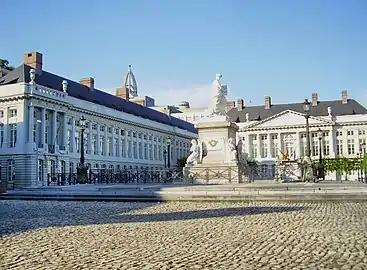
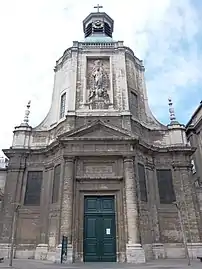 Church of Our Lady of Finistère
Church of Our Lady of Finistère
Freedom Quarter
The Freedom Quarter (French: Quartier des Libertés, Dutch: Vrijheidswijk) is situated between the Belgian Parliament and the Rue Royale/Koningsstraat, not far from the crossroads with the Small Ring, and has as its focal point the Congress Column, built in memory of the National Congress of 1830–31, the founder of democratic liberties in Belgium, under which also lies the tomb of the Unknown Soldier with an eternal flame. Not far from there is the Hotel Astoria, dating from 1911, which is currently being renovated and enlarged, and will be reopened in the coming years. In the 19th century, the district was known as Notre-Dame-aux-Neiges/Onze-Lieve-Vrouw-ter-Sneeuw and was inhabited in majority by working-class people. The authorities' desire to clean up the squalid parts of the city led to the expulsion of the population and the neighbourhood's complete destruction. A new bourgeois district was developed during the last quarter of the century. The choice was made to commemorate Belgian Independence: the Place de la Liberté/Vrijheidsplein ("Liberty Square"), the Place des Barricades/Barricadenplein ("Barricades' Square"), the Rue de la Révolution/Revolutiestraat ("Revolution Street"), the Rue du Congrès/Congresstraat ("Congress Street"), etc. The four streets overlooking the Place de la Liberté bear the names of the four constitutional liberties, symbolised by the four allegorical bronze female sculptures surrounding the Congress Column: Freedom of the Press, Worship, Association and Education. This eclectic urban complex is one of the best preserved of the Pentagon today.
 Congress Column (Leopold I, 1859)
Congress Column (Leopold I, 1859)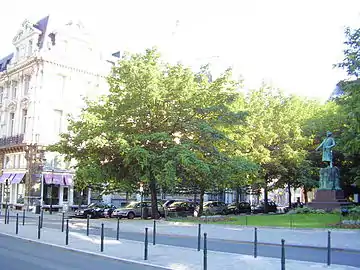
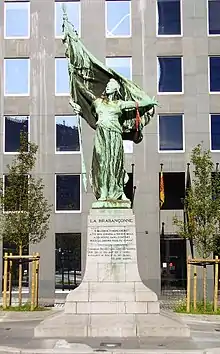

European Quarter and Leopold Quarter
The European Quarter (French: Quartier Européen, Dutch: Europese Wijk) is located to the east of the Pentagon, around the Place du Luxembourg/Luxemburgplein and the Robert Schuman Roundabout, and includes the smaller Leopold Quarter (French: Quartier Léopold, Dutch: Leopoldswijk). The European Parliament was built near the Place du Luxembourg, on the site of the former Leopold Quarter railway station, and of which only the central building overlooking the square remains, having been replaced by the underground Brussels-Luxembourg railway station. The European Commission, housed in the Berlaymont building, is located on the Schuman Roundabout, not far from the Cinquantenaire Park. Across the street stands the Justus Lipsius building and the Europa building (part of the Residence Palace), serving as the seat of the European Council and the Council of the EU. In Leopold Park, the House of European History (HEH) initiates visitors to the social history of the European continent. There is a visitor centre in the main European Parliament building, known as the Parliamentarium, and another smaller one in the Justus Lipsius building for the European Council. It is accessible on certain days, by appointment. Many of the attractions in the European Quarter are free to visit.


.jpg.webp)
 Espace Léopold buildings (European Parliament)
Espace Léopold buildings (European Parliament)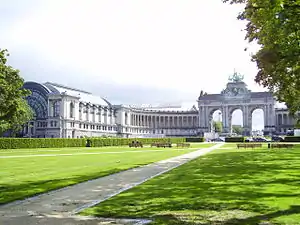
Squares Quarter
The Squares Quarter (French: Quartier des Squares, Dutch: Squareswijk) is the northern spur of the European Quarter, located between Saint-Josse-ten-Noode and the Leopold Quarter. The district is bounded by the Chaussée de Louvain/Leuvense Steenweg to the north, the Rue du Noyer/Notelaarsstraat and the Avenue de Cortenbergh/Kortenberglaan to the east, the Rue Joseph II/Jozef II-straat and the Rue Stevin/Stevinstraat to the south, as well as the Small Ring to the west. The toponym refers to the many squares in the area, in particular the Square Ambiorix/Ambiorixsquare, the Square Marguerite/Margaretasquare, the Square Marie-Louise/Maria-Louizasquare and the Avenue Palmerston/Palmerstonlaan. The area between the Small Ring and the Square Marie-Louise is sometimes considered to be part of the Leopold Quarter.
.jpg.webp)
.jpg.webp) Square Marie-Louise/Maria-Louizasquare
Square Marie-Louise/Maria-Louizasquare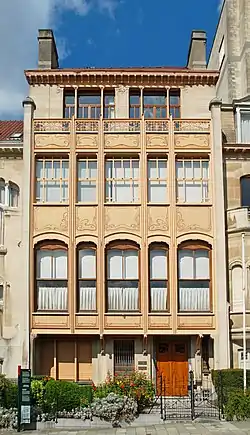
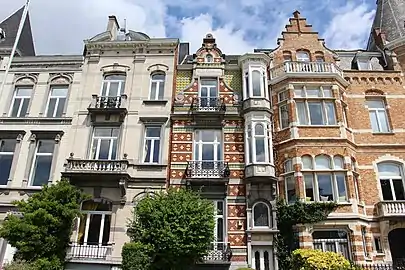 Avenue Palmerston/Palmerstonlaan
Avenue Palmerston/Palmerstonlaan
Laeken
Laeken is a former municipality in the north of the Brussels-Capital Region, annexed by the City of Brussels in 1921. Laeken is home to, among others, the Royal Domain of Laeken, the Palace of Laeken, the Royal Greenhouses of Laeken (1873), the Church of Our Lady of Laeken (whose crypt contains the tombs of the Belgian royal family) and Laeken Cemetery, known for its wealth of monuments and sculptures. On the territory of Laeken also lies the Heysel/Heizel Plateau, where were held the World's Fairs of 1935 and 1958 and which includes the King Baudouin Stadium, Bruparck (with the Atomium, Mini-Europe miniature park and Kinepolis cinema), the Centenary Palace, home to the Brussels Exhibition Centre (Brussels Expo), and the Port of Brussels, next to which the Monument to Work by Constantin Meunier was erected. On its southern part, it holds the former Tour & Taxis former industrial site, which was annexed to the City of Brussels in 1897, twenty-four years before the rest of the municipality.
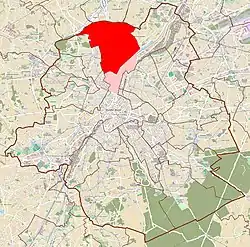 Map of Laeken
Map of Laeken
.jpg.webp)
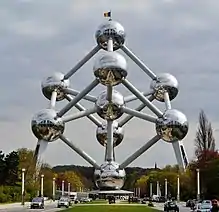
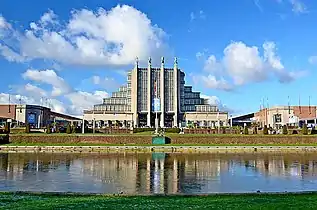
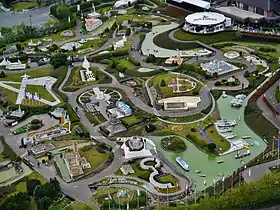
Mutsaard
Sometimes also known as the Pagoda district, the Japanese Tower district or De Wand district, Mutsaard (also spelled Mutsaert), is an old hamlet and a historic district located between Laeken and Neder-over-Heembeek and centred around the Place du Mutsaert/Mutsaertplaats or Mutsaardplein. The district was part of the former municipality of Laeken (postcode: 1020) but also a piece of Neder-over-Heembeek, annexed by Laeken in 1897. It is separated from the rest of Laeken by the Royal Domain and is the site of the Museums of the Far East. The district also extends a little on the neighbouring Flemish municipalities of Vilvoorde and Grimbergen.
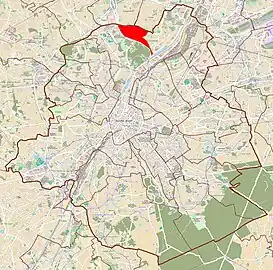 Map of Mutsaard
Map of Mutsaard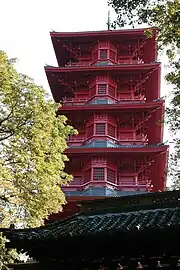
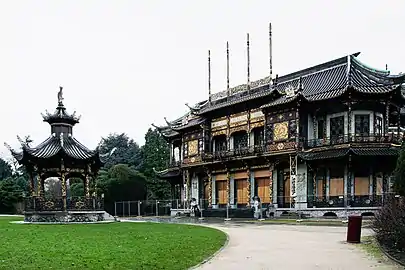 Chinese Pavilion
Chinese Pavilion
Neder-Over-Heembeek
Neder-Over-Heembeek is a former municipality incorporated in the City of Brussels in 1921, at the same time as Laeken and Haren. It has the distinction of having the oldest place name in the Brussels-Capital Region, as it was mentioned in an ordinance as early as the 7th century. This is where the Queen Astrid Military Hospital, which is the National Burns and Poisons Centre, as well as recruitment services of the Belgian Armed Forces are located.
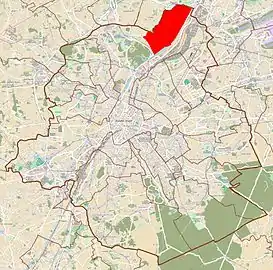 Map of Neder-Over-Heembeek
Map of Neder-Over-Heembeek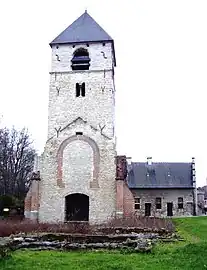 Old Romanesque tower in Lower Heembeek
Old Romanesque tower in Lower Heembeek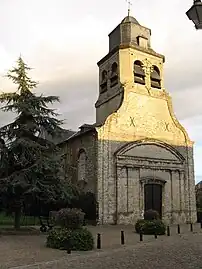 Church of St. Nicholas in Upper Heembeek
Church of St. Nicholas in Upper Heembeek
Haren
Like Laeken and Neder-Over-Heembeek, the former municipality of Haren was annexed by the municipality (City) of Brussels in 1921, which allowed the extension of Schaerbeek railway station north of its territory. But it is the presence, south-west of the town, of an airfield, created by the Germans during the First World War, and where the former Belgian national airline Sabena was born, which precipitated the annexation of Haren. For almost fifty years, Haren has been home to NATO's headquarters. It is also the location of many other administrations and companies, such as the headquarters of Eurocontrol.
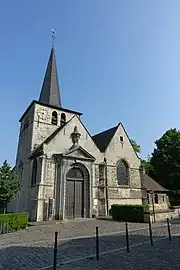 Church of St. Elizabeth
Church of St. Elizabeth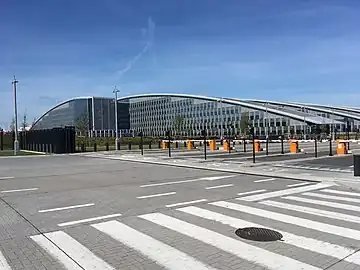 Headquarters of NATO
Headquarters of NATO Headquarters of Eurocontrol
Headquarters of Eurocontrol
Demographics
Foreign population
The City of Brussels has a large immigrant population, with both the EU and non-European migrant communities outnumbering the native Belgians. Like neighbouring Ixelles, Etterbeek and Schaerbeek, the City of Brussels also has a large Muslim population, mainly of North African origin.
As of 2023, taking into account the nationality of birth of the parents, 55.84% of the City of Brussels's population is from non-European countries (predominantly Morocco), 27.21% is from another European country (mainly France, Romania, Italy, Spain, and Poland), while the native Belgian population is 16.94%.[9] Among all major migrant groups from outside the EU, a majority of the permanent residents have acquired Belgian nationality.[10]
Migrant communities in the City of Brussels with over 1,000 people as of 1 January 2020:[11]
| 9,049 | |
| 7,431 | |
| 7,057 | |
| 5,175 | |
| 4,690 | |
| 2,777 | |
| 1,832 | |
| 1,758 | |
| 1,704 | |
| 1,591 | |
| 1,573 | |
| 1,565 | |
| 1,511 | |
| 1,389 | |
| 1,309 | |
| 1,177 |
| Group of origin | Year | |
|---|---|---|
| 2023[12][13] | ||
| Number | % | |
| Belgians with Belgian background | 32,916 | 16.94% |
| Belgians with foreign background | 85,377 | 43.94% |
| Neighbouring country | 4,194 | 2.16% |
| EU27 (excluding neighbouring country) | 6,629 | 3.41% |
| Outside EU 27 | 74,554 | 38.37% |
| Non-Belgians | 75,998 | 39.12% |
| Neighbouring country | 13,512 | 6.95% |
| EU27 (excluding neighbouring country) | 28,534 | 14.69% |
| Outside EU 27 | 33,952 | 17.47% |
| Total | 194,291 | 100% |
Politics
As in every other Belgian municipality, the City of Brussels is headed by a mayor, who should not be confused with the Minister-President of the Brussels-Capital Region or the Governor of Brussels-Capital. The current city council was elected in the October 2018 elections.[14] The current mayor of the City of Brussels is Philippe Close, a member of PS, who is in coalition on the municipal council with Ecolo - Groen, DéFI and Forward.[15]
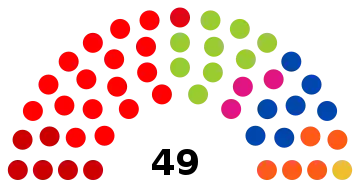 | ||||||||||
| Party | ||||||||||
|---|---|---|---|---|---|---|---|---|---|---|
| Votes | % | Swing (pp) | Elected 2018 |
Change | ||||||
| PS | 19,997 | 28.38 | 17 / 49 (35%) |
|||||||
| Ecolo - Groen | 11,847 | 16.81 | 9 / 49 (18%) |
|||||||
| MR - Open Vld | 9,772 | 13.87 | 7 / 49 (14%) |
|||||||
| PVDA-PTB | 8,159 | 11.58 | 6 / 49 (12%) |
|||||||
| cdH - CD&V | 6,543 | 9.29 | 5 / 49 (10%) |
|||||||
| DéFI | 5,317 | 7.55 | 3 / 49 (6%) |
|||||||
| N-VA | 2,606 | 3.70 | 1 / 49 (2%) |
|||||||
| Vooruit (Change Brussels) | 2,269 | 3.22 | New | 1 / 49 (2%) |
||||||
| VB | 1,138 | 1.61 | 0 / 49 (0%) |
- | ||||||
| ISLAM (political party) | 1,125 | 1.60 | 0 / 49 (0%) |
- | ||||||
| Others | 1,694 | 2.40 | 0 / 49 (0%) |
- | ||||||
Culture
Museums
There are many museums in and around Brussels' city centre. On the first Sunday of every month, free entry is granted to many of Brussels' museums. The Underwear Museum opened in 2009,[16] and was initially in the City of Brussels.[17] In 2016 it moved to Lessines, Hainaut, Wallonia.[18]
Below is a non-exhaustive list of museums in the City of Brussels:
- Royal Museums of Art and History :
- Royal Museums of Fine Arts of Belgium :
- Oldmasters Museum
- Magritte Museum
- Fin-de-Siècle Museum
- Wiertz Museum
- Meunier Museum
- Royal Museum of Modern Art
- Royal Museum of the Armed Forces and Military History
Food
Brussels is well known for its food. Brussels sprouts were named after the city.[19] Like most of Belgium, moules-frites, waffles (gaufres), chocolate, French fries, and beer are common there.[20] It is home to one 2-starred and four 1-starred Michelin restaurants.[21]
Honorary citizens
Among the recipients of the honorary citizenship of the City of Brussels are:[22]
| Date | Name | Notes |
|---|---|---|
| 29 June 1945 | Dwight D. Eisenhower | |
| 12 September 1945 | Bernard Law Montgomery, 1st Viscount Montgomery of Alamein | |
| 11 October 1945 | Charles de Gaulle | |
| 16 October 1945 | Sir Winston Churchill | |
| 16 April 1946 | Sir Arthur Coningham | |
| 26 May 1982 | Simone Veil | |
| 5 October 1984 | Maurice Béjart | |
| 24 April 1985 | Gaston Thorn | |
| 20 December 2001 | José Géal | |
| 8 September 2004 | Annie Cordy | |
| 18 May 2005 | José Van Dam | |
| 22 June 2005 | Marc Sleen | |
| 23 September 2005 | Alberto Uderzo | |
| 24 November 2005 | Jacques Van der Biest | |
| 20 December 2005 | Dick Annegarn | |
| 4 Februari 2006 | Guy Loiseau | President of the Order of the Friends of Manneken Pis[22] |
| 22 March 2006 | Marcel Hastir | |
| 12 June 2006 | Henri Vernes | |
| 24 June 2006 | Bernard Foccroulle | |
| 19 October 2006 | Jean-Baptiste Beken | Compagnon de Saint-Laurent[22] |
| 14 November 2006 | Cécile Muller | President of Miss Belgium |
| 5 May 2007 | Elisabeth t'Kint | Manager of the Cirque Royal[22] |
| 7 May 2007 | Julot Verbeeck | Press officer of the Cirque Royal[22] |
| 17 April 2008 | Expo 58 hostesses | |
| 12 October 2009 | William Vance | |
| 24 February 2010 | David Susskind (1925–2011) | Belgian Jewish Leader and Peace Activist.[23][24] |
| 12 May 2011 | Stéphane Hessel | |
| 22 November 2011 | Jean Van Hamme | |
| 25 September 2013 | Agnès Varda | |
| 29 March 2014 | Nathan Clumeck | Professor and managing director of the Saint-Pierre Hospital |
| 30 October 2015 | Grand Jojo | Also known as Lange Jojo |
| 25 March 2016 | Woltje | Puppet from the Royal Theatre Toone |
| 22 September 2017 | Arno | |
| 27 September 2018 | Diane von Fürstenberg |
Symbols
Heraldry
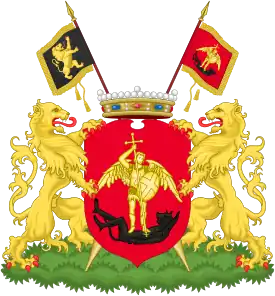 |
|
| Previous versions | |
|---|---|
.svg.png.webp) |
The Original arms were plain Gules.[26] From the 16th century on, it was customary to put the figure of the city seal representing Saint Michael, first as a shadow then in a more elaborate form.[27]
Note: many of the arms of the Seven Noble Houses of Brussels were variants of these arms. |
.svg.png.webp) |
1730 arms |
.svg.png.webp) |
Napoleonic arms[28] |
Vexillology
| Flag of the City of Brussels | |
|---|---|
 |
Description:
Green and red with at its centre Saint Michael slaying the dragon (Devil). Symbolism: Saint Michael is the patron saint of the city.[29] See: Saint Michael slaying the Devil |
See also
References
Footnotes
- Brussels is not formally declared capital of the EU, though its position is spelled out in the Treaty of Amsterdam.
Notes
- "Bevolking per gemeente op 1 januari 2022". Statbel.
- The Belgian Constitution (PDF). Brussels, Belgium: Belgian House of Representatives. May 2014. p. 63. Archived from the original (PDF) on 10 August 2015. Retrieved 10 September 2015.
- Demey 2007.
- "Protocol (No 6) on the location of the seats of the institutions and of certain bodies, offices, agencies and departments of the European Union, Consolidated version of the Treaty on the Functioning of the European Union, OJ C 83, 30.3.2010, p. 265–265". EUR-Lex. 30 March 2010. Archived from the original on 20 May 2013. Retrieved 3 August 2010.
- Picavet, Georges (29 April 2003). "Municipalities (1795-now)". Georges Picavet. Retrieved 5 April 2009.
- "Brussels Capital-Region". Georges Picavet. 4 June 2005. Retrieved 5 April 2009.
- Eggericx 1997, p. 26–28.
- "Origin | Statbel". statbel.fgov.be. Retrieved 4 July 2023.
- "2.738.486 inwoners van vreemde afkomst in België op 01/01/2012" [2,738,486 inhabitants of foreign origin in Belgium on 01/01/2012]. Npdata.be (in Dutch). Archived from the original on 22 October 2019. Retrieved 12 March 2013.
- "Nationalités | IBSA". ibsa.brussels. Retrieved 10 July 2023.
- Statistics foreign population in Belgium by municipality (in French and Dutch only)
- "Origin | Statbel". statbel.fgov.be. Retrieved 4 July 2023.
- "Résultats officiels des élections communales 2018" (in French). Retrieved 17 July 2021.
- "PS, Ecolo-Groen et sp.a ouvrent la majorité à Défi à la Ville de Bruxelles" (in French). 20 October 2018. Retrieved 17 July 2021.
- "Panty Poetry: Celebrity Underwear Museum Opens in Brussels". Spiegel Online. Der Spiegel. 23 July 2009. Retrieved 27 August 2018.
- "Le "musée du slip", dernière expérience surréaliste à Bruxelles". La Dépêche. 28 June 2009. Retrieved 27 August 2018.
(36 rue des Renards, 1000 Bruxelles).
- Boyle, Robyn (25 September 2016). "Underwear Museum moves from Brussels to Lessines". The Bulletin. Retrieved 27 August 2018.
- "Real Food Encyclopedia | Brussels Sprouts". FoodPrint. Retrieved 9 February 2021.
- 2venturists (10 June 2018). "What to Eat in Brussels Belgium". Venturists. Retrieved 8 February 2021.
- "Brussels 2 Stars MICHELIN MICHELIN Restaurants – the MICHELIN Guide Belgium". MICHELIN Guide. Retrieved 8 February 2021.
- "Ereburgers". opendata.brussel.be (in Dutch). Retrieved 14 May 2022.
- "City of Brussels". Archived from the original on 2 February 2017. Retrieved 20 September 2018.
- "World Jewish Congress".
- Netherlandish sculpture 1450-1550 by Paul Williamson 2002 ISBN 0-8109-6602-6 page 42
- Guillaume Des Marez, "L'origine des armoiries de Bruxelles. Première phase: De gueules plain", in: Études inédites, Brussels, 1936, p. 111-113.
- Louis Robyns de Schneidauer, La couronne comtale de la ville de Bruxelles, in Le Parchemin, Gendbrugge-lez-Gand, 1939 (March–April).
- (en)Brussels[archive], on the Heraldry of the World website.
- Netherlandish sculpture 1450-1550 by Paul Williamson 2002 ISBN 0-8109-6602-6 page 42
Bibliography
- Demey, Thierry (2007). Brussels, capital of Europe. S. Strange (trans.). Brussels: Badeaux. ISBN 978-2-9600414-6-0.
- Eggericx, Laure (1997). Les Boulevards du Centre. Bruxelles, ville d'Art et d'Histoire (in French). Vol. 20. Brussels: Centre d'information, de Documentation et d'Etude du Patrimoine.
External links
- Official website (in French, Dutch, and English)
- Official tourism website (in French, Dutch, English, German, Spanish, Italian, and Portuguese)
- Webcam Grand-Place Brussels
- Interactive map
